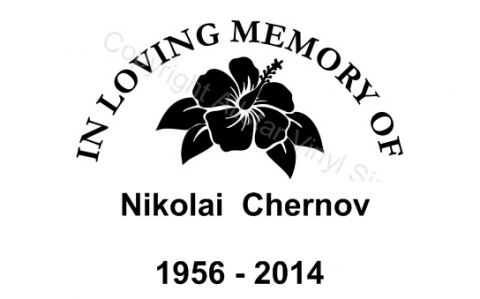TALK BY ROBERTO MARKARIAN BEFORE THE CONFERENCE GIVEN IN THE DYNAMICAL SYSTEMS, ERGODIC THEORY, AND PROBABILITY CONFERENCE DEDICATED TO THE MEMORY OF NIKOLAI CHERNOV (University of Alabama at Birmingham, May 18-20, 2015)
In June 91 I was invited by Professor Sinai to work in the Lev Landau Institute for Theoretical Physics, Moscow, and met Kolya who was working in the Joint Institute for Nuclear Research, Dubna. There, he and Vieta were living in a beautiful dacha, with a lot of carpets hanged in the walls; some of them were of Armenian origin. This was my first visit to an important scientific institute apart from IMPA, Rio de Janeiro, where I had studied with Jorge Lewowicz and Jacob Palis. Kolya had studied my first paper (that appeared in 1988[1]), and he knew it better than me; it was clear that he (and Sinai) had been the referees of the paper. Moreover, in a small book on billiard systems, in Russian, that Kolya wrote with Gregory Galperin, they refer to the “young Uruguayan mathematician, Roberto Markarian”, although I was already 42; confusion came from the fact that this was my first paper.
We began to work jointly in a lot of different topics in billiards mathematical theory. Our first joint paper appeared in 1992[2]. We met again in 1994, now in Princeton University. We began to study systems with holes and published 4 papers on this topic, some of them with Sergei Troubetzkoy, at this moment working here in Alabama. I visited Birmingham three times before now and I stayed in Kolya’s and Vieta´s home (in the basement), very close to their sons´ rooms.
In my last visit to Birmingham we began to work in our books. During this period we visited a lot of beautiful state Parks near by, with magnificent creeks, streams and falls. I don´t remember their names although I have a lot of pictures taken by Vieta and myself.
In May 2003, while I was visiting my daughter Vania who was finishing her PhD (in History) in Columbia University, we worked in the Institute of Advanced Studies in Princeton. There I met for the first time Dmitry Dolgopyat. I remember well that we (Dolgopyat and me) drank one bottle of wine in a vietnamese restaurant. I also remember very well our discussions with Kolya, walking in the beautiful gardens of the IAS, about the US invasion to Iraq that began in March 20, 2003.
At this time we began to prepare our last book that was published by the AMS in 2006[3], whose latter versions were prepared in Montevideo and Rio de Janeiro. Kolya stayed twice in my home and we visited some of the beautiful beaches of the Rio de la Plata. In one of our joint visits to IMPA, we stayed in the hotel Flamengo where the famous Uruguayan soccer world champion´s team stayed in 1950.
I consider myself a good friend of Kolya’s family and I am touched for being in this fully deserved commemoration. I am much in debt with him for all he helped me both personally and mathematically.






